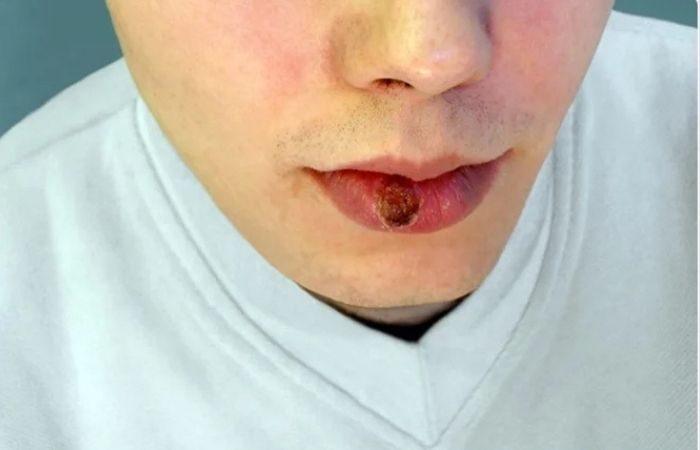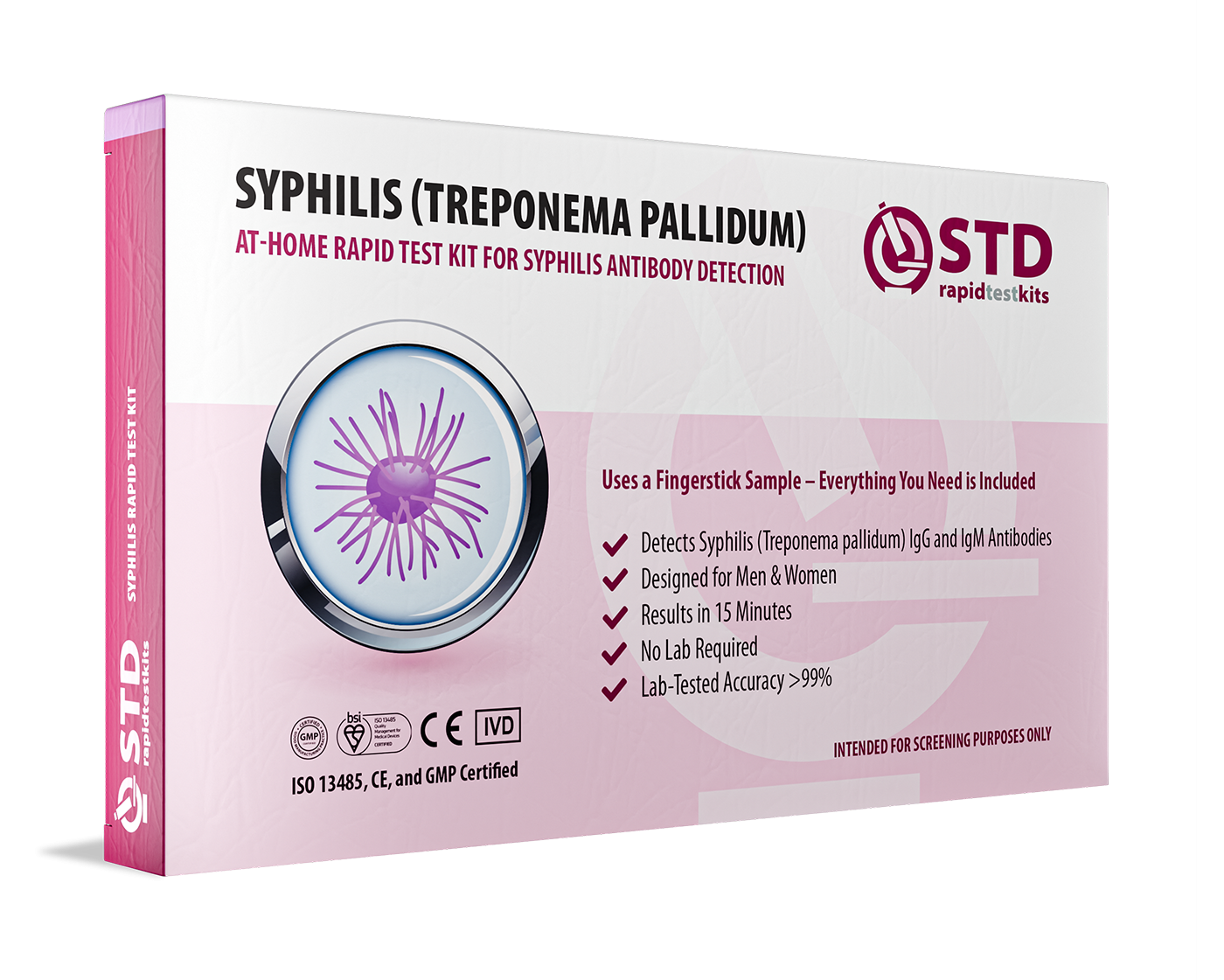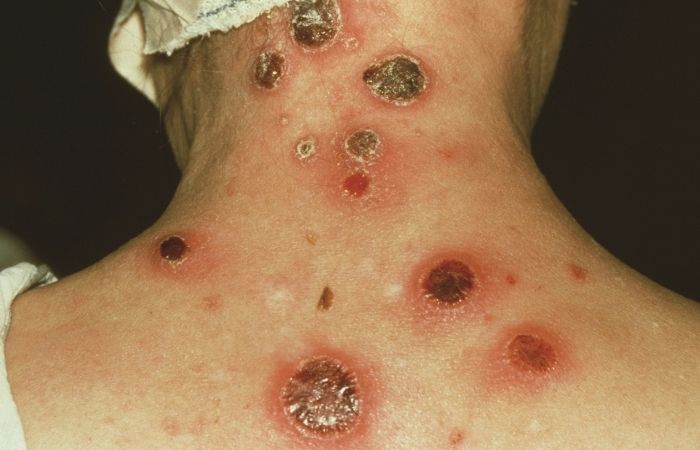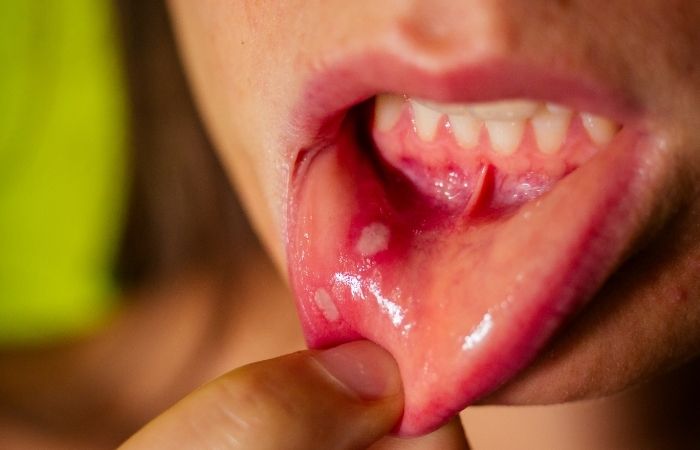Best At-Home STD Tests Compared: Speed, Accuracy, and Privacy
Overview of the Issue: What Exactly Is a Syphilis Chancre?
At the heart of every syphilis horror story, there’s a chancre, a word that sounds almost elegant but signals anything but. A chancre (pronounced shang-ker) is the classic first sign of syphilis infection. It’s typically a small, round, firm sore that pops up at the exact site where the bacteria Treponema pallidum first entered your body. For most people, that’s the mouth, the genitals, or the anus, but technically, it can appear anywhere that had intimate contact.
The truly terrifying part? A chancre doesn’t hurt. There’s no screaming red inflammation, no raging pain to demand your attention. Most people mistake it for a harmless pimple, a shaving cut, or even a herpes blister that’s “not acting normal.” Some never even spot it at all because it’s hidden in folds of skin, inside the mouth, or tucked away somewhere hard to see. Left untreated, the chancre heals on its own, but that’s no victory. It's simply the calm before the storm of secondary syphilis, which can be catastrophic without treatment.
Early detection is everything. And in case you're wondering, yes, you can test yourself confidentially with trusted at-home STD kits like the ones from STD Rapid Test Kits, and catch the infection before it wreaks havoc.

Key Benefits: Why Catching a Syphilis Chancre Early Is Life-Saving
You might wonder, what’s the big deal about spotting a sore early? Well, the benefits of catching a syphilis chancre while it's still fresh are enormous, literally life-changing. First and foremost, early diagnosis stops the infection before it enters the bloodstream, where it can travel to organs like your heart, brain, and eyes. Primary syphilis is like a campfire, manageable and small, but once it turns into secondary or tertiary syphilis, it’s an unstoppable wildfire.
If you recognize a chancre quickly, you can treat syphilis with a simple, powerful antibiotic shot, usually a dose of benzathine penicillin G. That’s right: a single shot can cure primary syphilis if caught early. There’s no need for a complicated regimen, no years of health consequences, no “what if” regrets gnawing at you in the middle of the night.
Another huge benefit? Protecting your partners. Syphilis is ruthlessly contagious during the chancre stage. Even if the sore is hidden inside the body and you don't see it, the bacteria are alive and ready to spread during any kind of sexual contact, oral, vaginal, anal. Identifying and treating a chancre early doesn’t just save your life; it shields everyone you’re intimate with from a painful, expensive, and risky infection cycle.
Early action also sidesteps the mental health nightmare that can come with late-stage diagnosis. Imagine finding out months later that you’ve been living with neurosyphilis symptoms, memory loss, mood swings, personality changes, when a tiny sore months before could have stopped it all. Getting checked the moment you spot something weird isn’t just a good idea. It’s an act of radical self-love.
Challenges or Risks, Why People Miss the Warning Signs
If syphilis chancres are so dangerous, why do so many people miss them? The answer lies in the cruel, cunning nature of syphilis itself.
First, the painless nature of a chancre tricks people into complacency. We’re conditioned to think that if something doesn’t hurt, it can’t be serious. Syphilis flips that logic on its head. No pain doesn’t mean no danger, it’s quite literally the opposite.
Secondly, location, location, location. A sore tucked deep inside the vaginal canal, behind the tonsils, inside the rectum, places you’re unlikely to casually examine, can go unnoticed for weeks. Some people might dismiss early symptoms altogether, especially if they coincide with other life events like starting a new relationship (where you might expect minor irritation) or simply being too busy to notice a subtle physical change.
Then there's the stigma. Even when people suspect something isn’t right, the fear of being judged keeps them from seeking help. Shame silences a lot of early syphilis cases. Nobody wants to walk into a clinic and say, “Hey, can you check this weird bump on my junk?” But silence is syphilis’s best friend.
Another risk? Misdiagnosis. Some healthcare providers, especially in areas where syphilis rates are lower, might mistake a chancre for a herpes sore, a bacterial infection, or even a minor injury. Without proper testing, like the rapid blood tests available through STD Rapid Test Kits, chancres can get dismissed until it's too late. Syphilis is a master of disguise. The only way to beat it is vigilance, curiosity, and courage.
Check Your STD Status in Minutes
Test at Home with RemediumSyphilis Test Kit

 For Men & Women
For Men & Women Results in Minutes
Results in Minutes No Lab Needed
No Lab Needed Private & Discreet
Private & DiscreetOrder Now $33.99 $49.00
Solutions or Recommendations: What You Should Do If You Spot a Sore
If you spot a suspicious sore, even if it seems innocent, take it seriously. Here's what you should do:
First, don’t self-diagnose. Yes, Google is comforting at 2 a.m., but no image search can replace a real test. At-home test kits, like those from STD Rapid Test Kits, offer a safe, private, and fast way to get real answers without leaving home.
Second, refrain from any sexual activity until you know what's going on. This protects your partners and helps stop the spread of syphilis.
Third, document the sore. Take clear, well-lit photos daily if possible. If you end up needing to show a healthcare provider (even through a telemedicine app), having a visual timeline can be invaluable.
Fourth, follow up rigorously. A single test might not catch very early syphilis infection if antibodies haven’t formed yet. If your first test is negative but you’re still suspicious, retest in a few weeks as advised by medical professionals.
Finally, tell your partners if you're diagnosed. This is not a betrayal of trust, it’s an act of responsibility. Early treatment can save them from serious harm too.
Statistical Insights and Data: Why Syphilis Isn’t a Disease of the Past
Despite what you might assume, syphilis isn’t some relic of pirate ships and powdered wigs; it’s surging back, harder than ever.
According to the CDC, syphilis cases in the U.S. have risen by over 74% in the past five years alone. Primary and secondary syphilis diagnoses, those early stages where chancres pop up, are at their highest rates since the 1950s. In particular, rates have exploded among certain populations, including men who have sex with men, but also in heterosexual communities and even among newborns via congenital syphilis.
One terrifying statistic: nearly 40% of people with syphilis chancres never realize they’re infected until they reach secondary syphilis stages, where full-body rashes, fevers, and organ damage begin. The silent nature of the chancre stage is a big reason why syphilis has staged this ugly comeback.

Expert Opinions and Case Studies, Real Lives, Real Risks
Take the case of “J,” a 28-year-old woman who assumed a painless sore inside her mouth was a canker sore. She ignored it, only to be diagnosed with secondary syphilis three months later after developing mysterious rashes on her hands and feet. Had she tested herself at the first sign, she could have avoided months of anxiety and antibiotic treatment.
Or Dr. Emily Ryan, an infectious disease specialist who warns, “Syphilis chancres are often so subtle that unless you’re actively looking for them, you miss them. We always advise people: if you’re sexually active and spot anything out of the ordinary, test immediately.”
And it's not just horror stories. People who catch syphilis at the chancre stage often never face another health consequence. The earlier you act, the easier the cure.
Historical Context, How Chancres Shaped History
Syphilis didn’t just pop up alongside Tinder and dating apps, it’s been haunting humanity for centuries, leaving a gory trail through history books. Some historians believe syphilis exploded into Europe in the late 15th century, possibly carried by Christopher Columbus’s sailors returning from the New World. What’s certain is that by 1495, syphilis was devastating armies, particularly during the siege of Naples, where soldiers reportedly suffered grotesque sores and eventual death.
The chancre stage has always been the silent signal, the tiny sore that whispered of much larger horror to come. In the 16th and 17th centuries, untreated syphilis led to grotesque deformities, madness, and early death among aristocrats, artists, and commoners alike. Figures like Al Capone, Oscar Wilde, and even Beethoven have been rumored to suffer from syphilis's long-term effects, often misdiagnosed in their time as dementia, madness, or divine punishment.
The tragic irony? Even centuries ago, the story started the same way: a small, painless sore that most people ignored. A sore that, if only it had been treated, could have changed the course of individual lives and maybe even history itself.
Order Now $69.00 $147.00 Check Your STD Status in Minutes
Test at Home with Remedium
3-in-1 STD Test Kit




For all 3 tests
Future Trends, The Battle Against Syphilis Isn't Over
Fast forward to today, and syphilis isn't going anywhere. In fact, experts warn that rising antibiotic resistance could make syphilis treatment more complicated in the future. While penicillin remains the gold standard, strains showing partial resistance to some antibiotics have already been documented.
In response, researchers are pushing for faster testing, better sexual health education, and more accessible at-home testing options like STD Rapid Test Kits. Public health organizations are also starting to emphasize routine syphilis screening for anyone sexually active, not just "high-risk" groups, a shift long overdue.
The future of syphilis control rests on early detection, public awareness, and breaking the silence that allows tiny chancres to become full-blown health crises. In a world of fast hookups and global travel, vigilance is our best defense.
Practical Applications, How to Protect Yourself Starting Today
Here’s the deal: you don’t have to become a paranoid recluse to avoid syphilis. Protecting yourself can be woven into everyday life in smart, empowering ways.
- Normalize Testing: Make STD testing as routine as dentist appointments. Every 3-6 months if you're sexually active, or immediately after any new unprotected encounter.
- Condoms Matter, But Aren’t Perfect: Condoms lower risk but don't eliminate it, since chancres can appear outside the area covered.
- Know Your Body: Get familiar with what your normal skin and mucous membranes look like. That way, any strange bump stands out immediately.
- Ask Partners About Testing: It’s not awkward; it’s survival.
- Use At-Home Testing Kits: If getting to a clinic feels impossible (or just intimidating), confidential testing kits like those from STD Rapid Test Kits let you take control quietly, quickly, and safely.
In other words: knowledge isn’t paranoia, it’s power.

Industry Impact, How Syphilis is Shaking Up Healthcare
Syphilis’s sneaky comeback is forcing the healthcare industry to rethink its strategies. Urgent care centers and general practitioners are seeing more cases, sometimes in patients who seem low-risk. Pediatricians are now screening pregnant women much more aggressively due to terrifying spikes in congenital syphilis, cases where babies are born infected.
Telemedicine services are expanding to offer remote STD consultations and prescriptions. Pharmaceutical companies are investing millions into developing faster point-of-care syphilis tests. Even dating apps like Tinder and Grindr are rolling out sexual health resources and testing reminders inside their platforms.
In short: syphilis is rewriting the rules, and industries are scrambling to catch up.
Personal Stories or Testimonials,: When One Tiny Sore Wasn't So Tiny After All
"A" was a 22-year-old university student who spotted a small bump at the base of his penis after a weekend getaway. It didn’t hurt, so he shrugged it off. Three months later, he found himself hospitalized with blurred vision and headaches, early neurosyphilis. "I had no idea a tiny bump could cause so much damage," he says now. "If I'd known, I would've gotten tested that week."
Meanwhile, "M," a 35-year-old mother of two, caught her syphilis at the chancre stage thanks to routine at-home testing. "It was literally the size of a sesame seed," she recalls. "I thought I was overreacting, but testing saved me from months of hell."
The moral is clear: that tiny sore isn’t just a blemish, it’s a battle flag. And you either fight now, or face the consequences later.

FAQs
1. What does a syphilis sore actually look like in real life?
Usually round, firm, red or flesh-colored, and surprisingly neat, almost clinical in appearance.
2. Is a syphilis chancre itchy at all?
Nope. Not itchy, not painful, that's why it tricks people into ignoring it.
3. Can a syphilis sore pop up inside my mouth?
Absolutely. Oral sex is a common transmission route.
4. How long does a syphilis sore last?
Typically 3 to 6 weeks, even if untreated.
5. Can you have multiple chancres at once?
Yes, though one sore is more common, multiple can occur.
6. What’s the fastest way to test for a syphilis chancre?
A rapid blood test, many at-home kits can now deliver results in minutes.
7. If the sore goes away, am I cured?
Not even close. The infection continues inside your body unless treated.
8. Can I get syphilis from non-sexual contact?
Extremely rare, but theoretically possible through open wound exposure.
9. How soon after infection does a chancre appear?
Usually 10 to 90 days after exposure, with 21 days being typical.
10. Can I safely treat a syphilis chancre at home without seeing a doctor?
No. Only prescribed antibiotics can cure syphilis, you must seek treatment.
Don't Let a Tiny Sore Wreck Your Life
It’s wild how something so small could wield so much power over your future. One sore. One missed warning. One untreated infection. That’s the brutal reality of syphilis, and the syphilis chancre in particular. But here's the truth you need to hang onto: it’s 100% preventable.
If you stay curious about your own body, stay vigilant after sexual encounters, and test yourself without shame, you turn that silent threat into a minor inconvenience instead of a lifelong disaster. Don’t give syphilis a chance to sneak past you. Recognize the sore. Respect the risk. Respond with action. Because when it comes to syphilis, what you don't see, or refuse to see, can absolutely hurt you.
Sources
1. Ending HIV Australia – Syphilis Symptoms in Men
2. POZ Magazine – The Secret Life of Syphilis
3. Verywell Health – Syphilis Sores: Everything to Know About Chancres
4. Healthline – Syphilis: Symptoms, Causes, Diagnosis, Treatment










